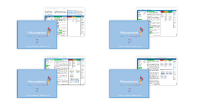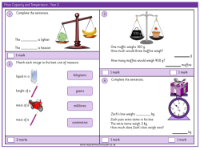Mass, Capacity, Temperature - Vocabulary

Maths Resource Description
When teaching Year 2 students about mass, capacity, and temperature, a variety of key vocabulary terms are introduced to aid their understanding of these concepts. For mass, terms such as 'balance scales' and 'scales' are described as equipment used to measure the mass of an object, with mass being the weight of that object. Students learn to 'weigh' items, determining whether they are 'heavier' or 'lighter' by using units such as 'grams' (g) and 'kilograms' (kg). In terms of capacity, the volume that a container can hold is explored, using units like 'millilitres' (ml) and 'litres' (l). Students will understand terms such as 'full', 'half full', 'empty', and 'half empty' to describe how much a container holds.
Temperature is another important concept covered, where 'degrees Centigrade' (°C) is used as the standard unit of measurement. A 'thermometer' is the equipment used to measure how hot or cold something is, with terms like 'warmer' and 'colder' used to compare temperatures. The curriculum also introduces the ability to 'estimate', 'compare', and understand when one quantity is 'more than', 'less than', or 'equal to' another. This comprehensive vocabulary forms the foundation for students to assess and understand the physical properties of objects and substances they encounter in their environment.

